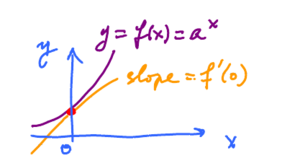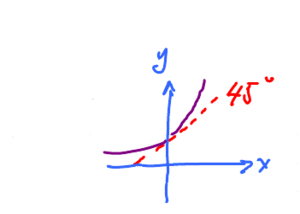This site is being phased out.
Differentiation without limits: part 1
The derivative is defined as a limit. Can we evaluate derivatives without using limits?
Let's try the power functions and see if there is a pattern: $$ \begin{aligned} (x^{1})^{\prime} & = 1, \\ (x^{2})^{\prime} & = 2x^{1}, \\ (x^{3})^{\prime} & = 3x^{2}. \end{aligned} $$ How? From the definition, $$ \begin{align} (x^{3})^{\prime} & = \lim_{h \to 0}\dfrac{(x + h)^{3} – x^{3}}{h} \\ & = \lim_{h \to 0} \dfrac{(x + h - x)((x + h)^{2} + (x + h)x + x^{2})}{h} \\ & = \lim_{h \to 0} \left[ (x + h)^{2} + (x + h)x + x^{2} \right] \quad \text{ , substitute } h = 0 \\ & = x^{2} + x^{2} + x^{2} = 3x^{2} {\text{ , keep in mind that x is fixed as far as the limit is concerned.}} \end{align} $$
Similarly, $$ (x^{4})^{\prime} = 4 x^{3} $$ A pattern emerges: $$ \begin{aligned} (x^{\color{maroon}{1}})^{\prime} & = \color{maroon}{1}x^{\color{maroon}{0}}, \\ (x^{\color{maroon}{2}})^{\prime} & = \color{maroon}{2}x^{\color{maroon}{1}}, \\ (x^{\color{maroon}{3}})^{\prime} & = \color{maroon}{3}x^{\color{maroon}{2}}. \\ (x^{\color{maroon}{4}})^{\prime} & = \color{maroon}{4}x^{\color{maroon}{3}}. \\ ....... \\ (x^\color{maroon}{n})^{\prime} & = \color{maroon}{n} x^{\color{maroon}{n - 1}}, \end{aligned} $$ where $n$ is an integer.
Also works for all other real $n$, turns out. For example, $$ \begin{align} \left( \dfrac{1}{x} \right)^{\prime} & = \lim_{h \to 0} \dfrac{\dfrac{1}{x+h}- \dfrac{1}{x}}{h} \\ & = \lim_{h \to 0} \dfrac{\dfrac{x - (x + h)}{(x + h)x}}{h} \\ & = \lim_{h \to 0} - \dfrac{1}{(x + h)x} \quad \text{ substitute } h = 0 \\ & = -\dfrac{1}{x^{2}} \end{align} $$
How does this fit into the above pattern? Rewrite as: $$ \dfrac{1}{x} = x^{-1}, \dfrac{1}{x^{2}} = x^{-2}, \ldots $$ So $$ (x^{-1})^{\prime} = -x^{-2} $$ If $n = 1$, then $n-1 = -2$, so the formula works.
To summarize Power Formula. $$ (x^{r})^{\prime} = r x^{r - 1}, \quad \text{ for any real number, } r $$
We won't call it "rule" or "law" because it's about a specific function. Compare to:
- Sum Rule (of derivatives)
- $$(f(x) + g(x))^{\prime} = f^{\prime}(x) + g^{\prime}( x)$$
- for any differentiable function $f\cdot g$ wrt $x$.
Proof.
$$\begin{aligned}(f(x) +g(x))^{\prime} & \overset{def}{=} \lim_{h \to 0} \dfrac{[ f(x + h)+ g(x+h) ] – [ f(x) + g(x) ]}{h} \\& \text{Idea: Just move the stuff around and collect g's and f's separately – to find their difference quotients.} \\& = \lim_{h \to 0} \dfrac{ f(x + h) – f(x) + g(x + h) – g(x)}{h} \\ & = \lim_{h \to 0} \left[\dfrac{ f(x + h) – f (x)}{h} + \dfrac{ g(x + h) – g(x)}{h} \right] \\ & \text{By sum rule of limits} \\ & = \lim_{h \to 0} \dfrac{f(x + h) – f(x)}{h} + \lim_{h \to 0} \dfrac{g(x + h) - g(x)}{h} \\ & = f^{\prime}(x) + g^{\prime}(x) \end{aligned}$$
Similarly,
Difference Rule. $$( f(x) - g(x) )^{\prime} = f^{\prime}(x) – g^{\prime}(x), $$
- for differentiable $f$ and $g$.
There is a counterpart for each limit law!
Constant Multiple Rule. $$(cf(x))^{\prime} = cf^{\prime}(x)$$ for differentiable $f$ at $x$.
Proof. $$ \begin{aligned} (cf(x))^{\prime} & = \lim_{h \to 0} \dfrac{cf(x + h) – cf(x)}{h} \\ & = \lim_{h \to 0} \dfrac{c( f(x + h) – f(x))}{h} \\ & \text{By CMR for limits} & = c \lim_{h \to 0} \dfrac{f(x+h) –f(x)}{h} \\ & = cf^{\prime}(x) \end{aligned} $$
Let's try to apply these.
Example: $(x^{2} + x^{3})^{\prime} = \lim_{h \to 0} \tfrac{(x + h)^{2} +(x + h)^{3} - x^{2} - x^{3}}{h}$. Seems like a lot of work...
Instead use SR and PF: $$\begin{aligned} (x^{2} + x^{3})^{\prime} & = (x^{2})^{\prime} + (x^{3})^{\prime} \\ & = 2x +3x^{2} \end{aligned} $$
Example: We can differentiate any polynomial easily now: $$\begin{aligned} (x^{77} + & 5x^{18} + 6x^{3} - x^{2} + 88)^{\prime}, \quad \text{ try } (x+h)^{77} !\\ & \overset{\text{SR}}{=} (x^{77})^{\prime} + (5x^{18})^{\prime} + (6x^{3})^{\prime} - (x^{2})^{\prime} + (88)^{\prime} \\ & \overset{\text{CMR}}{=} (x^{77})^{\prime} + (5x^{18})^{\prime} + (6x^{3})^{\prime} - (x^{2})^{\prime} + 0 \\ & \overset{\text{PF}}{=} 77x^{77 - 1} + 5\cdot 18x^{13 - 1} + 6\cdot 3x^{3 - 1} - 2x^{2 - 1} \\ & = 77x^{76} + 90x^{17} - 18x^{2} - 2x \end{aligned}$$
Example: $$\begin{aligned} (\sqrt{x})^{\prime} & = \underset{\text{where } r = \frac{1}{2}}{(x^{\frac{1}{2}})} \\ & \overset{\text{PF}}{=} \underset{\text{where }rx^{r-1}}{\frac{1}{2}x^{\frac{1}{2} - 1}} \\ & = \dfrac{1}{2}x^{\frac{1}{2}} \\ & \frac{1}{2\sqrt{x}}. \end{aligned}$$ But for what values of $x$?
What is the domain? $[0, \infty)$. The function is defined at 0, but not differentiable at 0. $\frac{1}{2\sqrt{x}}$, Domain: $(0, \infty)$
We need more derivatives for more functions.
Consider, $f(x) = a^{x}, a > 0$. But SR, CMR don't help here. We'll need to do some algebra.
$$ \begin{aligned} (a^{x})^{\prime} = f^{\prime}(x) & = \lim_{h \to 0} \frac{f(x + h) – f(x)}{h} \\ & = \lim_{h \to 0} \frac{a^{x + h}- a^{x}}{h} \qquad \left[\frac{0}{0} \to \text{ need algebra} \right] \\ & = \lim_{h \to 0} \frac{a^{x} a^{h} - a^{x}}{h} \qquad{\text{(Rule of exponents)}} \\ & = \lim_{h \to 0} \frac{a^{x}(a^{h} -1)}{h} \qquad \text{ factor it } \\ & \overset{\text{CMR}}{=} a^{x} \lim_{h \to 0} \frac{a^{h} - 1}{h} \qquad \text{This limit exists! What is it?} \\ & = a^{x} \lim_{h \to 0} \frac{a^{h} - a^{0}}{h}, \qquad \text{ similar to } \frac{a^{x+h} - a^{x}}{h} \\ & \text{Turns out this is the derivative of the function at 0} \\ & = a^{x}\cdot f^{\prime}(0) \\ & \text{This is what we have} \\ \therefore (a^{x})^{\prime} & = a^{x}\cdot \underbrace{f^{\prime}(0)}_{\text{What is it?}} \end{aligned} $$ It's the slope of the curve at the $y$-intercept (we assume that $f^{\prime}(0)$ exists).
We are mostly interested in one exponential function, the one with $f^{\prime}(0) = 1$. It's the "best" one! That's $e^{x}$. So $$(e^{x})^{\prime} = e^{x} $$ from the above formula.
Sometimes we prefer to use $\tfrac{d}{dx}$ for derivative. Then this is the form of the sum rule: $$\frac{d}{dx}(f(x) + g(x)) = \frac{df}{dx} + \frac{dg}{dx}.$$ But this is the most compact: $$(f+g)^{\prime} = f^{\prime} + g^{\prime} $$
Continue to Differentiation without limits: part 2.

